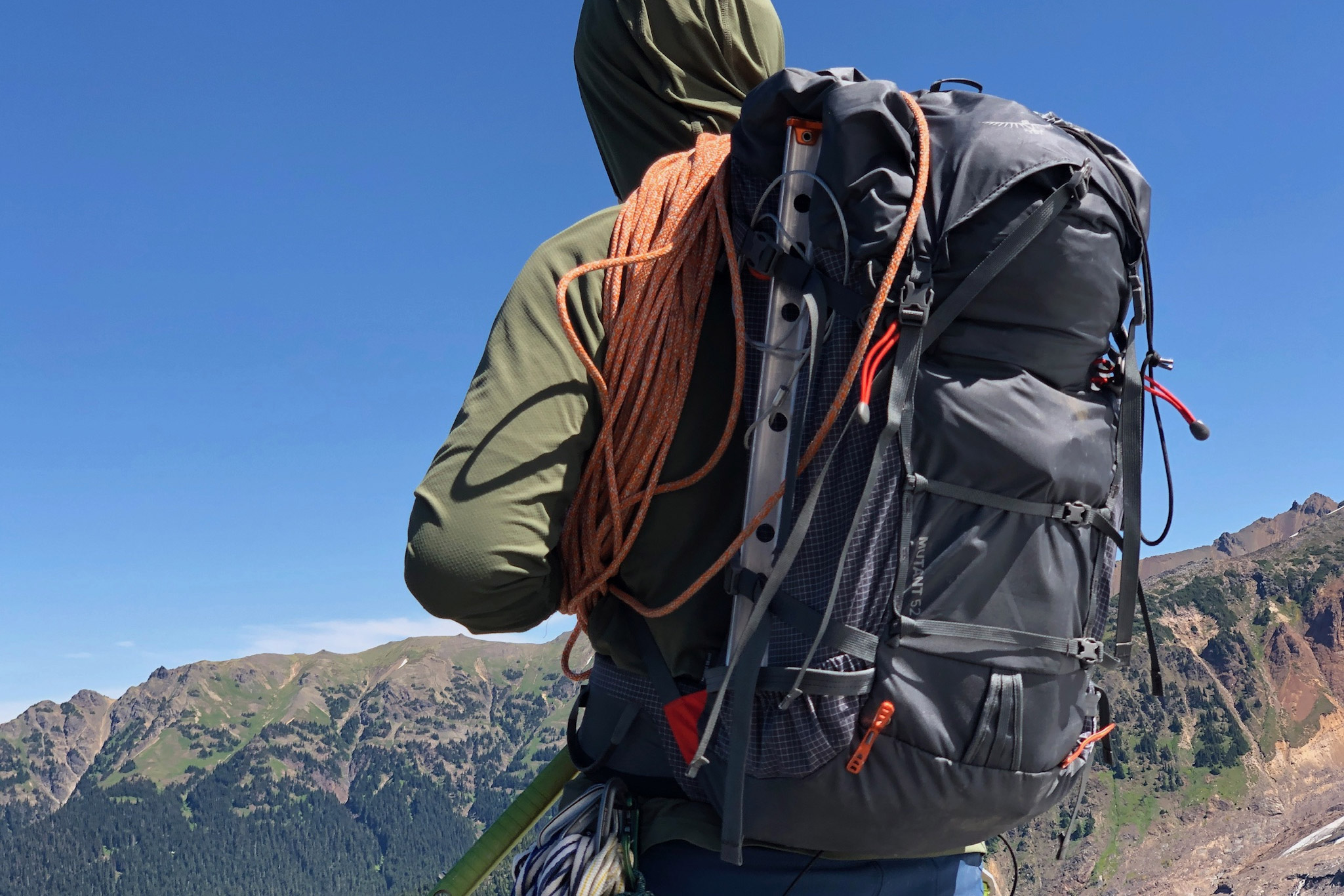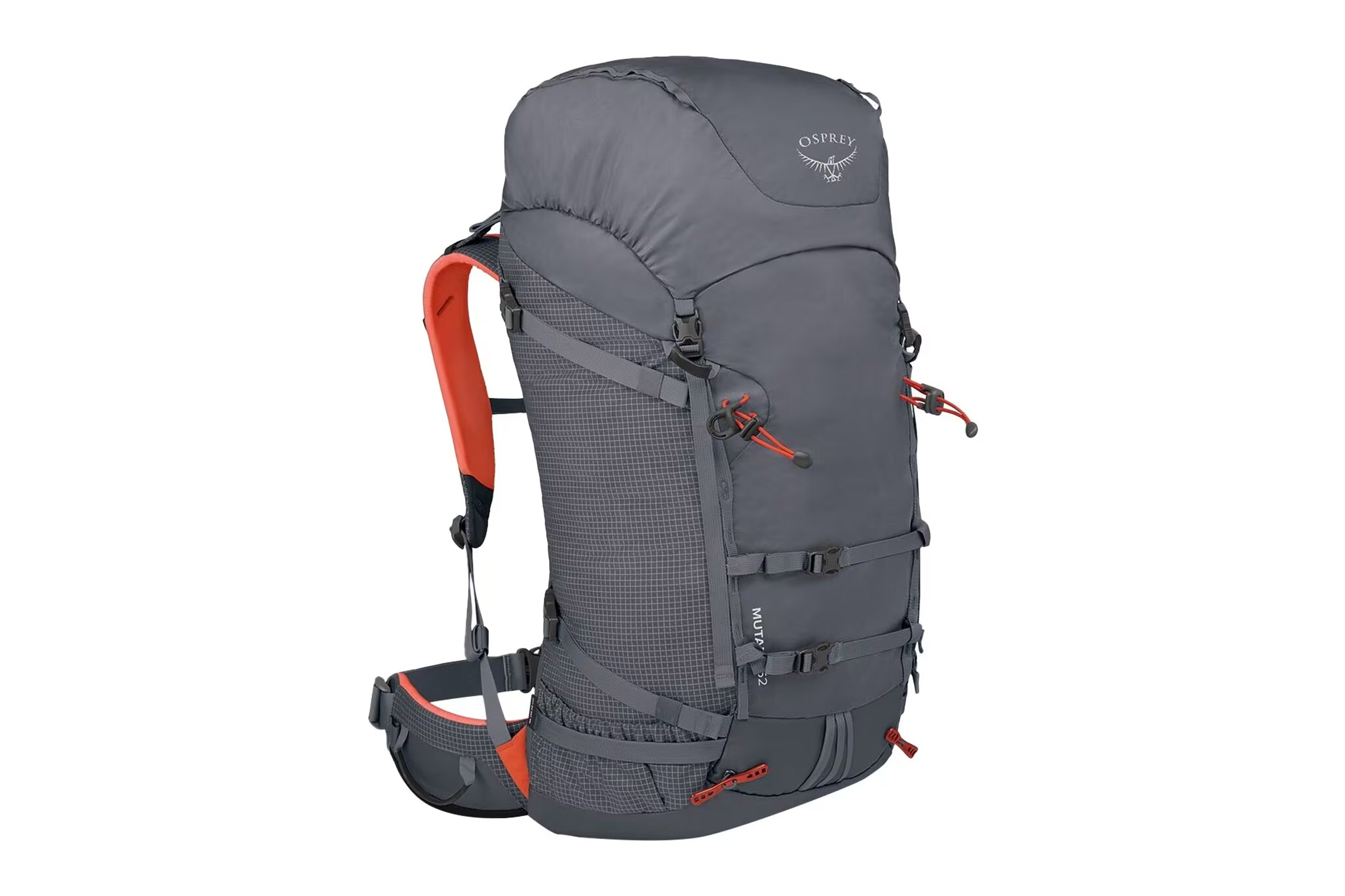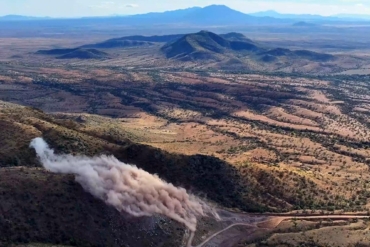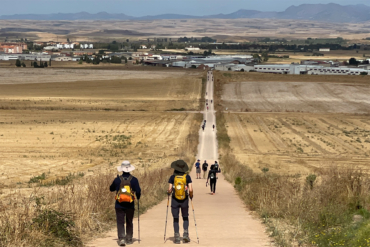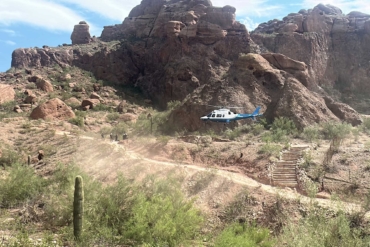I dragged the Mutant 52 out of my car at the trailhead deep in the heart of Colorado’s Gore Range. It was June 20, my annual last weekend of backcountry skiing for the year. The 52L Mutant was stuffed full. Then I pulled out my tote bag, and it too was full of backpacking and mountaineering gear that I somehow needed the Mutant to carry. A rope, crampons, ski boots, tent poles, and my helmet. Oh, and skis. Plus all the last-minute snacks I tossed in the car, and a few beers for good measure.
I started stuffing, strapping, looping, and stretching gear all over the outside. The Mutant was unfazed — it had an attachment feature for all of it. I never quite reached maximum capacity despite my best efforts. That was the basic theme every time I called on this pack to haul gear into the mountains.
It’s not just a hauler though — the second-generation Mutant 52 is ready to pare down and move with you for the full length of your mountain objective, whatever that looks like.
In short: Mountaineering packs face a complicated task. They must carry markedly heavy loads comfortably over long distances, secure bulky gear, and then cinch down to a fraction of their original size for technical climbing and summit pushes. Unlike most packs in the 50L realm, Osprey’s new Mutant 52 ($230) meets those needs in their signature feature-rich fashion. The Mutant can haul days’ worth of backpacking and mountaineering gear comfortably and pare down to stay out of the way. Plus, it’s burly enough to withstand hauling and repeated rocky abuse. Mountaineers, alpine climbers, ice climbers, backcountry skiers, and backpackers searching out technical scrambles will all find a feature set for them here.
- Material: 210D nylon (main, accent), 420D nylon (bottom)
- Volume: 50L (small/medium), 52L (medium/large)
- Suspension: Removable Atilon sheet lamination, HDPE top stay
- Shoulder straps: Laminated EVA
Pros
- A feature set for every mountain activity
- Carries heavy loads comfortably
- Pares down when you need it to
- Has an immense capacity thanks to thoughtful straps and attachments
Cons
- Hip belt is not removable
- On the heavier side of mountaineering packs
- Some may find that there are too many features
Osprey Mutant 52L Backpack: Review

Body
There’s a lot to unpack here. Truly, the Osprey Mutant 52 has a lot of features — a full set for alpine climbing, ice climbing, mountaineering, ski mountaineering, and general backpacking gear use. At the core of how it succeeds as a one-pack quiver across this spectrum is its ability to pare down. This pack, dare I say, mutates to the situation.
The other characteristic that sets it apart from other mountaineering packs in the 50L category is carrying comfort. Climbing packs can feel severe under a heavy load in the name of light-and-fast movement. The Mutant ditches that paradigm in favor of actual comfort. It sports a removable back panel, thoroughly adjustable shoulder straps, and a padded hip belt to help distribute the load.
Internal Storage for Backpacking and Mountaineering Gear

In mid-July, I found myself hoofing 40 pounds of backpacking and mountaineering gear up the approach to Mt. Baker’s Coleman glacier in the Northern Cascades on a classic mountaineering trip. The Mutant was once again stuffed full.
When we landed at the trailhead an hour earlier, our gear exploded over the parking lot — 3 nights’ worth and all the mountaineering gear needed to navigate Mt. Baker’s glaciers. There was what looked like at least 80 L of gear sitting in front of me, and I hadn’t even added food or water yet.
I started by stuffing the sleeping bag uncompressed into the bottom. Then came the puffy jacket and outerwear. Then I layered the carabiners, ice screws, a harness, and slings. That I topped off with a first-aid kit, 3 days’ worth of freeze-dried meals, crampons, and the rest of the odds and ends.
The Petzl RAD Line layered over that and cinched down under the brain. It all fits without fuss. The rest of the kit melded seamlessly to the outside.

The shape of the Osprey Mutant 52 is interesting. Instead of a tall, narrow tube, it’s wider at the top than the bottom. The wide opening helps with backpacking gear access given the lack of a side access zipper. The shape also helped the pack move through tricky terrain — there’s less junk down low to get snagged while bushwhacking and scrambling.
There’s a generous hydration sleeve inside the main compartment that does an effective job of holding a bladder, the hose of which routes out to the shoulder. I rarely use a bladder. Instead, I used this sleeve to holster objects that I either needed to access fairly frequently during summit pushes, like gloves, or ones that didn’t fit as neatly in the main compartment.
When warranted, I’d toss my shovel handle in there, along with the probe, snow saw, and tent poles. That way, they held close to the back panel in lieu of a dedicated avalanche tools pocket.
External Straps

The Mutant’s exterior is packed with features. For example, its front daisy chain attachment loops that run parallel to each other down the front of the pack were designed around standard Voile ski straps. The backpacking or mountaineering gear that you can attach to the front panel is literally endless. I attached tent poles, trail runners, used blue bags (gross), trekking poles, and even a last-minute baguette.
The ice tool carry is simple and effective. Dogbones poke through the eyes of ice tools and ice axes, keeping the tool’s pick secured under a webbing bridge at the front of the pack. It doesn’t quite eat the pick’s point like my favorite system on The North Face Phantom, but they’re locked in there despite the points being exposed.

The Osprey Mutant 52L gets a gold star for the ice tool shaft attachment. Two rubberized “ToolLocks” with bungee tie-offs cinch down over the tool’s shaft. There’s no need to slide the shaft through before attaching the picks (as is typical), and there’s thankfully no Velcro involved.
There are about a million other straps and loops on the outside of this pack. They’re a tiny bit annoying, yes, but Osprey put versatility at the forefront here. You can attach anything to this pack, including skis in an A-frame arrangement via generous side compression straps.

The helmet attachment net is another standout feature. It pulls out of a pocket just above the brain’s main zipper up and over your helmet, securing the daisy chain on the top of the brain, locking the helmet in place.
It’s so secure that I ended up using the space inside the helmet for additional storage, especially for gear I’d need to access on the approach — a sun hoodie, my bag of snacks, gloves, etc. Plus, it keeps the pack’s outer daisy chain area clear for other items, like crampons and baguettes.
Removable Brain

If I had to pick one, my favorite of the Mutant 52’s features is its ability to function and look great without a brain. If it’s so easy, why hasn’t every pack company made it happen? Osprey has this angle nailed on most of its larger packs.
The brain (or lid) connects to the main pack via four buckles: Two that stay clipped behind the base of the shoulder straps, and two that reach down the front of the pack to secure the lid over the main pack compartment.
When you pull the brain off, a secret flap (the FlapJack) pulls from near the haul loop that functions as a simple cover over the main compartment’s drawstring top closure. It secures to the same front buckles that the brain previously occupied. It’s a somewhat superfluous feature, but it makes the top of the pack look and feel tidy. The FlapJack’s buckles do, however, bottom out fairly quickly when the pack isn’t full.
This is a stellar feature for multiday climbing and skiing trips. I would move my overnight backpacking or mountaineering gear, toiletries, etc., to the brain and leave that in the tent, and take the rest of the pack to the summit or out for the ski day. That way, the brain doesn’t flop around over a relatively empty pack.
Too Many Features?

This is the most fully featured mountain pack I’ve ever used. There are just an incredible number of details, straps, and pockets. They’ve thought of everything and included it. That design ethos is not for everyone — some old-school or minimalist climbers might hanker for a simple tube-style pack with none of the bells, whistles, and modern comforts of the Mutant 52.
I tested The North Face Phantom 38 earlier this year, which is on the other side of the complexity spectrum. It’s a tube with a small lid and a few well-placed straps — a basic recipe well executed. Which one is better? The 14L size difference aside, it depends on your personal preference. Unless you’re really leaning into the fast and light angle, the Mutant holds a lot more gear both inside and out. The Mutant also carries heavy loads more comfortably.
One feature that the Mutant 52 doesn’t have is a removable hip strap. Some alpine climbers carrying a full rack of cams, nuts, and other gear might find this annoying, but most users won’t care. The hip belt is low-profile and comfortable, even with a harness on. Plus, it’s got gear loops on both sides.
Osprey Mutant 52 Durability

After 2 months of intensive use, there’s nary a scuff on the Osprey Mutant 52. No broken buckles, no scratches from dragging, and my ragged ski edges failed to slice the 210D recycled high-tenacity nylon body material even under tension. OK, there’s one puncture in the domed cinch collar from a clumsy piolet swing, but I’ll take the blame on that one.
I’m not worried about this stout pack’s lifespan. But if I was, I’d be relieved to know that it’s covered under Osprey’s All Mighty Guarantee. They’ll fix or replace all their packs, no matter how old they are. It’s one of the best warranties out there. I know from experience that they aren’t kidding about it — their handiwork saved my Xenith 88 pack from a premature demise after 10 years of heavy use.
Osprey Mutant 52L: Conclusion

Mountaineering gear is heavy and bulky; carrying it thousands of vertical feet over many miles is just plain hard. The Osprey Mutant 52 was designed to soften the bite, and it does an admirable job. While it adds 3.5 pounds to the payload, it carries all the aluminum, steel, nylon, and overnight gear required for 3- to 5-night mountaineering objectives more comfortably than most, if not all, of the packs in its class.
Plus, its feature-forward design adds a ton of versatility for all the sub-disciplines of mountaineering. Ski mountaineering? Check. Backpacking? It’s got that covered. There’s not a lot that this sturdy 52L pack can’t do.
